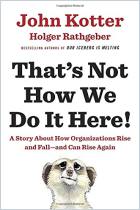
The Starfish and the Spider
The Unstoppable Power of Leaderless Organizations
Recommendation
In 1946, after intensive research, Peter Drucker wrote Concept of the Corporation, a study of decentralization at General Motors. Drucker's book had a profound influence on the business world, particularly on Japanese auto manufacturers, such as Toyota, which incorporated many of his ideas into its operations with great success. Flash forward to 2006, when Ori Brafman and Rod A. Beckstrom wrote this pivotal book about "leaderless organizations." Their insightful analysis concerns the remarkable organizational revolution under way as hierarchies (spider entities) give way to decentralization (starfish entities). The fundamental tension between these two forces remains a pivotal dynamic in business. Today's decentralization movement makes awareness even more critical. GM failed to learn from Drucker's book. This turned out to be a huge mistake. getAbstract recommends: Do not make the same mistake with this important book; it should not be ignored.
Summary
About the Authors
Ori Brafman and Rod A. Beckstrom are successful entrepreneurs who hold M.B.A.s from Stanford. They co-founded Global Peace Networks, an organization of CEOs dedicated to conflict resolution and economic development in Africa and the Middle East.

















Comment on this summary or Comenzar discusión